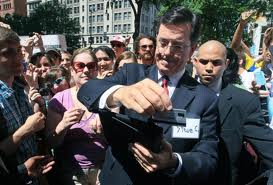 On June 30th, the Federal Election Commission (FEC) voted to approve Stephen Colbert’s (a comedian and host of the Comedy Central Colbert Report) application to form what is called a “SuperPac”. According to NPR and other various report, Colbert left the hearing room, went outside to a throng of supporters, and started accepting people’s credit cards. He used a credit card swipe machine attached to an iPad to process contributions from enthusiastic supporters.
On June 30th, the Federal Election Commission (FEC) voted to approve Stephen Colbert’s (a comedian and host of the Comedy Central Colbert Report) application to form what is called a “SuperPac”. According to NPR and other various report, Colbert left the hearing room, went outside to a throng of supporters, and started accepting people’s credit cards. He used a credit card swipe machine attached to an iPad to process contributions from enthusiastic supporters.
In the wake of the ruling, Colbert launched his Colbert SuperPac website, started taking online contributions, and now scrolls the names of his donors along the bottom of the television screen during his shows.
Over the last month, I’ve watched this fundraising drama unfold and found myself wondering: “Is this some kind of bizarro, alternative fundraising universe?”
What I thought I was seeing was average people pulling out their wallets and throwing money at an organization that didn’t have a mission, vision, or case for support. Go to the Colbert SuperPac website, click around and try to find any of that information. It doesn’t really exist. What does this organization stand for? What will this organization support? How will it support those things it believes in?
You will find no answers. As a matter of fact, Colbert interviewed political analyst Matthew Dowd on his show about this very subject, and in the end he concluded that he would ask his donors what his SuperPac should symbolize and support. As a non-profit fundraising professional, it took me a long time to wrap my mind around the idea of going to a donor, asking for a contribution, and then asking the donor what they think your mission, vision, case for support, and programming should be.
My Dad has said I am not the sharpest knife in the drawer; however, after many walks and conversations with my dog, I have come to the conclusion that this is NOT a bizarro, alternative universe for fundraising professions.
There is a very witty and satirical case for support that Colbert’s super-smart audience understands. It isn’t written in a case for support document or a glossy solicitation brochure. The SuperPac’s case for support is embodied in a series of “comedy bits” that Colbert has been airing ever since the Supreme Court’s controversial “Citizens United” decision in 2010.
In a nutshell, the Colbert SuperPac’s case goes something like this: “Making a contribution to this undefined political action committee will allow us to demonstrate to the FEC, policymakers, and the Supreme Court that there are dangers and unforeseen consequences of such a decision. Your contribution also helps test a hypothesis that unlimited ‘free speech’ can have adverse consequences on democratic institutions. In the end, your contribution might even save our American democracy.”
Now THAT is an amazing case for support, which must be why so many people are lining up to give Colbert SuperPac their money.
OK … now that I’ve convinced myself that the fundraising universe hasn’t been turned upside down, I see all sorts of fundraising lessons for non-profit organizations and fundraising professions such as:
- Your organization’s case for support needs to be POWERFUL if you want to be serious about raising money.
- Your fundraising efforts will benefit greatly if you find the right voice to talk about your case for support.
- People will contribute only if you ask them. So, stop beating around the bush and dropping hints.
- Allowing donors to swipe their credit card will help inspire spontaneous giving.
- Taking contributions online via your website needs to be supported by multi-channel cultivation, solicitation and stewardship activities.
Well, you’ve been watching the same things I’ve been watching . . . what are your observations? What fundraising best practices are you seeing? Is there a moral to the story for fundraising professionals? Please use the comment box to share your thoughts because we can all learn from each other!
Here is to your health!
Erik Anderson Owner, The Healthy Non-Profit LLC eanderson847@gmail.com http://twitter.com/#!/eanderson847 http://www.facebook.com/eanderson847 http://www.linkedin.com/in/erikanderson847